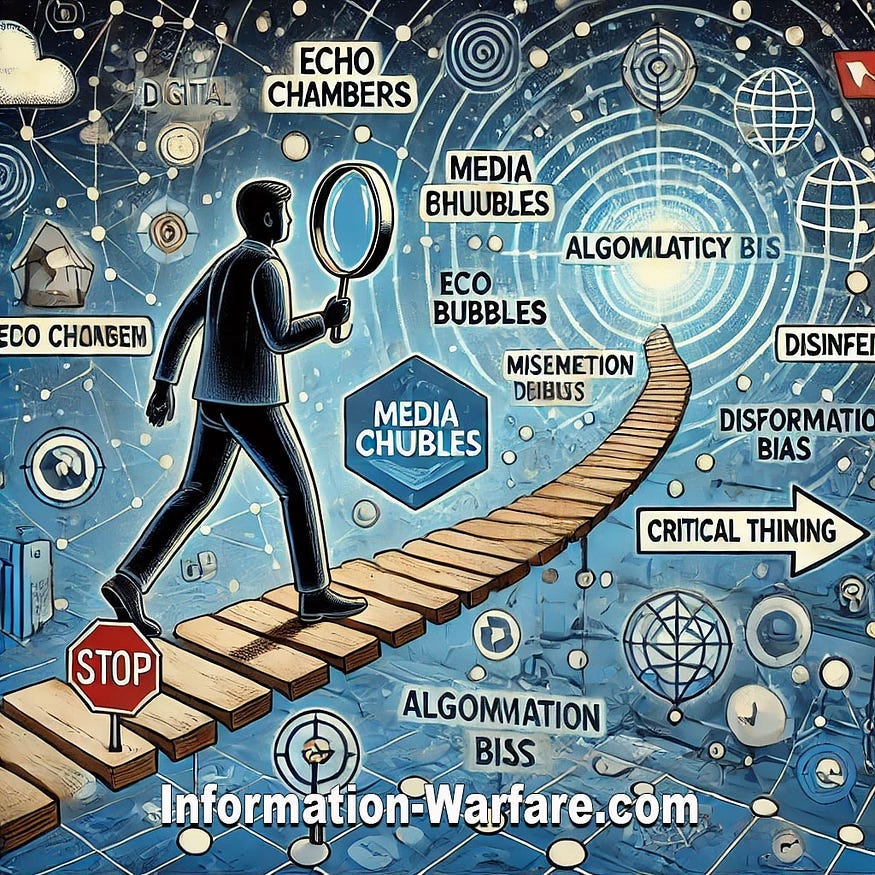Navigating the Information Wave: Skills for Recognizing Echo Chambers, Media Bubbles, and Other Pitfalls
Essential Awareness for Identifying and Avoiding Misinformation, Disinformation, and Algorithmic Bias in the Digital Age

Identifying Echo Chambers, Media Bubbles, and Other Information Wave Pitfalls
Echo Chambers:
Definition: Online spaces where users only encounter information or opinions that reflect and reinforce their own.
Identification:
Homogenous Friend Lists: Social media circles consist primarily of people with similar views.
Repetitive Content: Seeing the same viewpoints and information repeatedly without significant variation.
Lack of Exposure: Rarely encountering differing opinions or challenging perspectives.
Media Bubbles:
Definition: Situations where individuals are only exposed to news and content from a limited number of sources that align with their existing beliefs.
Identification:
Single Source Dependency: Relying on a narrow range of media outlets for news.
Confirmation Bias: Preferring news that confirms pre-existing beliefs while ignoring contradictory information.
Limited Diversity: Few to no alternative viewpoints represented in the consumed media.
Algorithmic Bias:
Definition: The tendency of algorithms to reinforce user preferences, leading to personalized but narrow content feeds.
Identification:
Tailored Content: Platforms show content based on past behaviors, likes, and interactions.
Predictable Feeds: Content on social media or news platforms seems excessively tailored to individual interests and views.
Lack of Variety: Rarely encountering surprising or new topics outside of usual interests.
Misinformation:
Definition: False or inaccurate information spread unintentionally or through misinterpretation.
Identification:
Unverified Sources: Content lacks credible or traceable sources.
Sensational Headlines: Eye-catching headlines that seem too extreme or incredible.
Lack of Consensus: Information that credible news sources or experts dispute.
Disinformation:
Definition: Deliberate spread of false information with the intent to deceive or mislead.
Identification:
Clear Agenda: Content appears to serve a specific political, ideological, or financial agenda.
Fact-Check Warnings: Information has been flagged by reputable fact-checking organizations.
Anonymity: The source of the information is obscure or anonymous, making accountability difficult.
Clickbait:
Definition: Content designed to attract attention and encourage clicks, often at the expense of accuracy or depth.
Identification:
Misleading Titles: Headlines promise more than the article delivers.
Low-Quality Content: The article’s substance is minimal, with a focus on sensationalism.
High Ad Density: Content surrounded by numerous advertisements, indicating a profit motive over informational value.
Propaganda:
Definition: Biased or misleading information used to promote a particular political cause or point of view.
Identification:
One-Sided Stories: Content heavily favors one perspective without presenting counterarguments.
Emotional Appeal: Strong emotional language aimed at eliciting a specific reaction.
Repetitive Messaging: Consistent repetition of the same messages across multiple channels.
Filter Bubbles:
Definition: Situations where algorithms selectively present information to users based on their preferences, isolating them from opposing viewpoints.
Identification:
Monotony: Content is highly consistent with personal views and preferences.
Isolation: Little to no exposure to diverse or opposing viewpoints.
Predictive Feeds: Algorithms accurately predict and cater to preferences, reducing the chance of encountering varied information.
Astroturfing:
Definition: Coordinated campaigns that appear to be grassroots movements but are actually orchestrated by organizations or governments.
Identification:
Coordinated Messaging: Similar messages appear simultaneously across multiple accounts or platforms.
Suspicious Origins: Campaigns that lack a clear, transparent origin or backing.
Uniform Support: Unnaturally uniform support for specific ideas or causes without genuine grassroots involvement.
By being aware of and identifying these pitfalls, individuals can better navigate the information wave, protect themselves from manipulation, and contribute to a more informed and resilient society.

